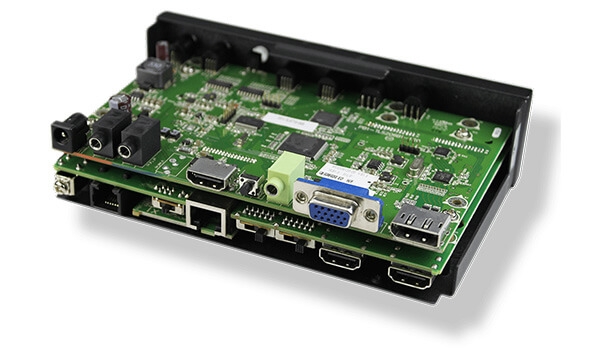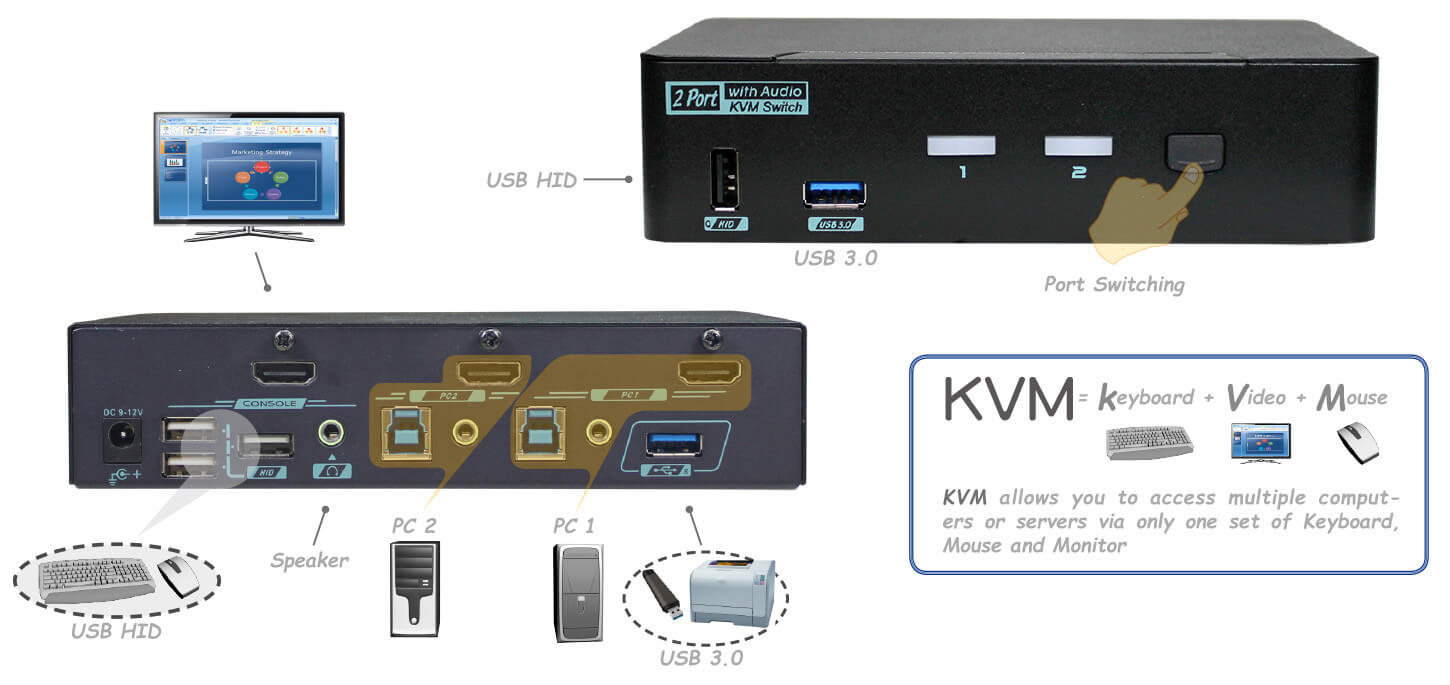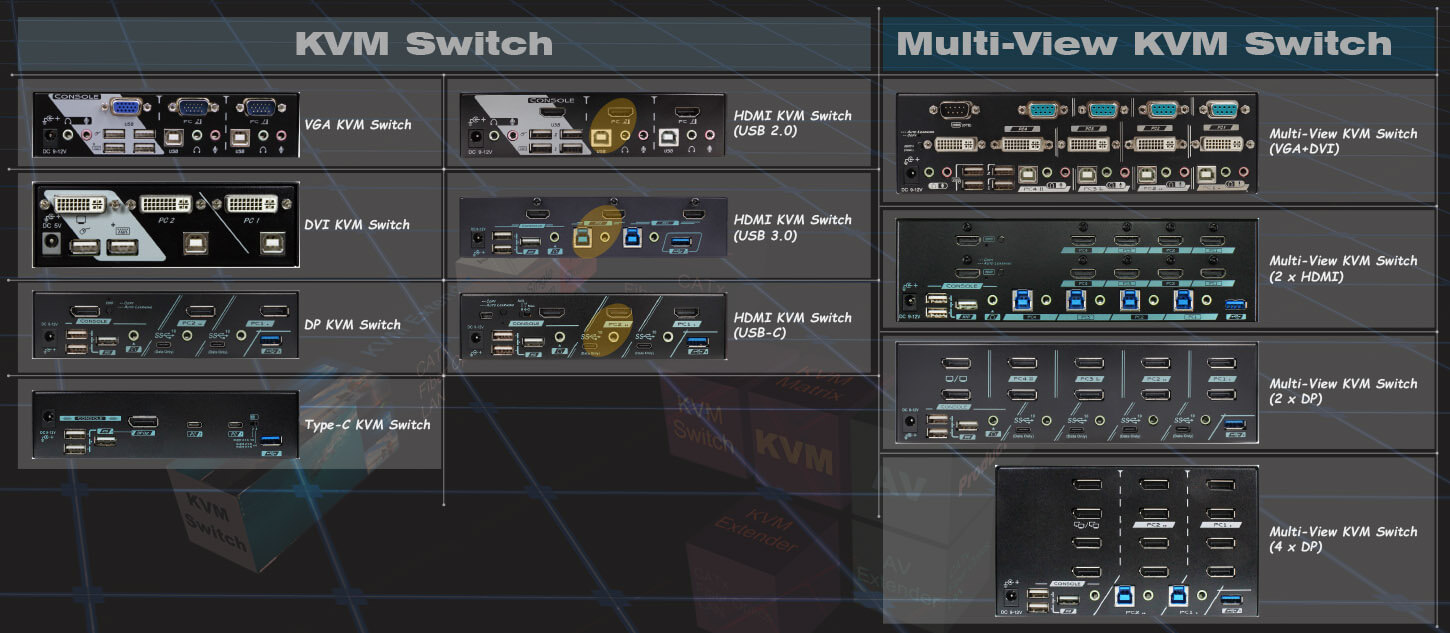What Is KVM Switch and What is it Used for?

What is a KVM Switch?
A KVM switch, which stands for "Keyboard, Video, and Mouse" switch, is a hardware device that enables multiple computers to share a single keyboard, video display, and mouse. This compact and easy-to-use solution eliminates the need for extra cables and software installations, promoting a tidy and organized work environment while saving valuable space, time, equipment, and money.
KVM switches are available in various types and configurations, including desktop switches, rack-mounted switches, and scalable switches capable of supporting hundreds of computers. They offer different connection options such as VGA, DVI, HDMI, USB, USB-C, and PS/2, catering to diverse setups and requirements. Some KVM switches also provide additional features like audio support, remote access, and convenient hotkey functions, facilitating seamless switching between computers.
Furthermore, advanced security features are often integrated into KVM switches to ensure protection against unauthorized access and potential data breaches. These features allow businesses and organizations to maintain control over their IT resources while streamlining workflow and boosting productivity.
Overall, a KVM switch is a valuable tool for simplifying the management and control of multiple computers from a single workstation. Its ability to optimize workflow and enhance productivity makes it an essential asset for businesses relying on efficient utilization of IT resources.

What is a KVM switch used for?
A KVM switch is a device that enables you to use one keyboard, monitor, and mouse to control multiple computers in various situations. The acronym KVM stands for Keyboard, Video, and Mouse, and it provides a convenient solution for saving space, time, and money. For example, you can use a KVM switch to easily switch between your work computer and personal computer at home without requiring extra peripherals. It also allows you to access different operating systems or applications on different computers without the need to restart or log out. Some KVM switches even support additional devices such as audio, USB, and HDMI.
A KVM switch is also a device that assists system administrators in controlling multiple computers from a single workstation in different IT environments, such as data centers and server rooms. By connecting the keyboard, video display, and mouse inputs, users can switch between computers by pressing a dedicated button on the KVM switch, using hotkey commands, or activating an on-screen display (OSD) window. This eliminates the need for physical access to the servers, improving security, efficiency, and reliability. A KVM switch also enables users to perform tasks like troubleshooting, maintenance, installation, and configuration on any server in the rack. Some KVM switches even allow remote access over the network or the internet, enabling remote management and monitoring of the servers.
KVM switches process multiple video and peripheral signals and provide a single output to only one screen, keyboard, and mouse—or vice versa (reverse KVM switch). KVM switching allows operators to quickly access several computing data sources or AV signals. The technology is operating system agnostic and transparent to all applications. Application scenarios include desktop switching in offices, medical imaging, broadcast, post-production, and command and control rooms. Many businesses use server rooms to securely store dozens or even hundreds of servers. In this scenario, IT staff can control all servers connected to a KVM switch with just one keyboard, monitor, and mouse. This saves a significant amount of time, allowing for the smooth completion of even the most advanced processes.
Types of KVM Switches
KVM switches have different types and sizes, depending on how many computers they can control, what kind of video signal they support, how many monitors they can display, and how they can be switched. Some common types of KVM switches by type of connectivity are:
- Desktop KVM switches: These are small devices that usually control two to eight source PCs to one or two monitors. They support various display connectors such as VGA, DVI, DisplayPort, and HDMI. They also support different peripheral and audio inputs such as USB, PS/2, and analog or digital audio. They can be placed on a desktop or mounted behind a screen or underneath a table.
- KVM Matrix Switches: These are devices that allow multiple users to access multiple sources like PCs and servers in a matrix of switchable endpoints. They use a transmission medium such as CATx, fiber, or IP to connect all endpoints over small to large distances. They support a wide range of display, peripheral, and audio interfaces such as VGA, SDI, Composite, DVI, DisplayPort, HDMI, USB 2.0/3.1, PS/2, serial formats such as RS232, Infrared, digital and analog audio, and more. They are used in applications such as broadcast, medical imaging, digital signage, and command and control rooms.
- KVM over IP switches: These are devices that allow users to control multiple PCs and servers over a network, from anywhere at any time. They can be used in a dedicated IP network, a LAN (Local Area Network), or even over a WAN/Internet. They are ideal for medium to large installations and data centers that require several users to manage a number of computers or servers.
- HDMI KVM Switches: These are devices that provide HDMI signal switching without compromising video quality. They offer fast switching times without delays. They are ideal for applications such as broadcast, high-end medical imaging, interactive digital signage, home theatres, and industrial automation.
- DVI KVM Switches: These are devices that provide reliable digital video experience using single-link or dual-link DVI-D or DVI-I signals. They can also support analog VGA signals using a passive or active video converter. They are ideal for critical enterprise-level applications where reliable digital image quality and fast switch-over of redundant hardware are required.
- DisplayPort KVM Switches: These are devices that provide peripheral sharing when users need to share more USB peripherals among all computers. They allow users to access high-performance graphical workstations and critical video processors from secure and temperature-controlled equipment rooms while maintaining the same user desktop experience.
- VGA KVM Switches: These are devices that provide a smooth real-time switching experience for up to 1920x1200 VGA signals. They support dual, triple, or quad VGA video connectors for easy access to video heads on each channel.

Buying Guide of KVM Switch
When choosing a suitable KVM console, you need to clarify many important factors of the use environment, such as:
- Number of sources
- Number of users controlling the computer
- Video type
- Number of monitors: Single or multiple
- Resolution and performance
- Audio Support
- Support USB peripherals
- Digital and front-end IP switches
- Distance requirement
- Safety certificate
- Integrated remote power management function
- Support serial device
- Bandwidth
Only by selecting according to the needs can the KVM selector's effectiveness be maximized.
Why choose Rextron KVM Switch?
Rextron KVM switch is a product that lets you choose multiple computers with different methods, such as pressing buttons on the front panel, using hotkey commands or activating OSD, and switching the mouse.
Expandability: Rextron offers KVM switches with 2/4/8/16 ports for Windows, Sun, Linux, and Mac systems, and you can manage up to 136 servers easily by connecting multiple KVM switches together.
Resource Sharing:Rextron KVM switch has USB 3.2 Gen 1 ports that give you great I/O speed for sharing USB devices.
Multi-video operation:You can use dual monitor, triple monitor, or quad monitor KVM switches for different purposes, such as working, gaming, or 3D graphic designing.
Multi-Format Video:Rextron KVM supports various video formats, such as VGA/ DVI/ HDMI/ DisplayPort/ Mini DisplayPort/ Multi-format, that work with the latest computer graphics cards.
Rextron International Inc. is a leading company in the IT field that was founded in 1998. It has a lot of experience and skill in developing and designing KVM, Matrix, and Extender products integration for the market. It is known for making high-quality IT-related products and has earned the trust of clients from over 50 countries worldwide.
Design, Research and Development, manufacturing, 100% Made in Taiwan
We are committed to providing our customers with engineering and manufacturing service, innovative design, and systematic production processes that include board design, PCB layout, software package development, and test, artwork and mechanical drawing, packing, and certification along the way to fulfill the requirement of the growing market. Rextron protects its own innovation and intellectual property rights and respects others as well. It invests a lot in applying for patents every year and has more than 100 patents on KVM products.
IT-related products like Console Drawer, KVM Switch, and KVM Extender for server room control, AV-related products such as Video Switches, Splitter, Matrix, Extender, Converter, and EDID Reader for the consumer market, and Data Communication devices including Serial Extender, USB Extender, and USB Switch for a related industrial chain. Rextron does its best to design state-of-the-art products for education, health system, enterprise, and commercial market. Our latest AV over IP KVM extender gives end users a more flexible and easier way to transmit video and audio signals over an Ethernet-based network. In the future, we will continue to develop innovative, simple, and intuitive designs for our clients by satisfying their needs.
